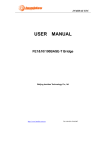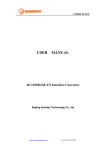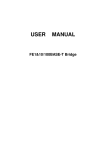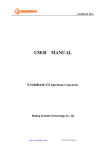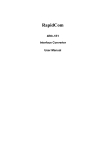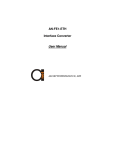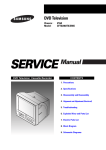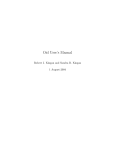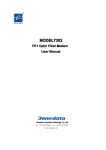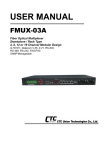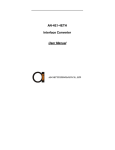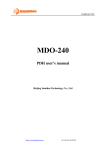Download USER MANUAL FE1&10/100BASE
Transcript
INMIDAS TEC USER MANUAL FE1&10/100BASE-T/2E Bridge Beijing Inmidas Technology Co., ltd http://www.inmidas.com.cn Tel: +86-010-51662447 MEL-100FB Installation and Operation Manual Content 1. Product description ...................................................................................................................... 2 2. Main features ................................................................................................................................ 2 3. Technical specifications............................................................................................................... 3 4. Installation and panel description............................................................................................... 4 4.1 Unpacking (stand alone FE1&10/100BASE-T/2E Bridge)................................................ 4 4.2 Front and rear panel of the stand alone device.................................................................. 4 4.2.1 The front panel of the FE1&10/100BASE-T /2E Bridge .................................................... 4 4.2.2 The rear panel of the FE1&10/100BASE-T/2E Bridge ....................................................... 5 4.2.3 System test and configuration.............................................................................................. 6 5. Applications of FE1&10/100Base-T /2E Bridge ....................................................................... 6 5.1 Definition of balanced twisted-pair wire sequence for RJ45 interface ............................ 6 5.1.1 10/100BASE-T interface wire sequence.............................................................................. 6 5.1.2 E1 interface wire sequence .................................................................................................. 6 5.2 Setting of DIP switch and jumper ......................................................................................... 7 5.2.1 Setting of E1 interface impedance....................................................................................... 7 5.3 Configuration of Ethernet connecting devices.................................................................... 7 5.4 Simple self-test methods for devices and E1 circuits........................................................ 8 5.5 Typical applications ................................................................................................................ 8 5.6 Common questions and their maintenance ........................................................................ 9 http://www.inmidas.com.cn Tel: +86-010-51662447 Page 1 of 11 MEL-100FB Installation and Operation Manual 1. Product description FE1&10/100BASE-T/2E Interface Converter (also as FE1&10/100BASE-T/2E Ethernet Bridge) is an Ethernet bridge of high performance, which accomplishes the converting between the 100M Ethernet port and the E1 port. As an extended device of the Ethernet, the FE1&10/100BASE-T/2E bridge realizes interconnection of two Ethernet by using the E1 channel provided by existing networks with low cost. 10/100Base-T (RJ45) interfaces are provided at the end of Ethernet LAN to accomplish various functions including double Ethernet interface broad band shared, MAC address self-learning, address filtering, address table maintenance and flow control. For the client which only require not more than 2 Ethernet, it can be reduce the net node, dispense with the device as HUB, consequently reduce the malfunction node. E1 interfaces conforming to ITU-T G.703 and G.704 proposals are provided at the end of WAN, supporting RJ45 and BNC connection modes. The E1 ports support both framing and un-framing architecture. The user can select an operating mode for the E1 interface according to the connected E1 environment. This provides flexibility of network application. In the framing mode, the E1 interface provides a rate of N*64Kbps(N=1~31). In the un-framing mode, the E1 channel provides a rate of 2.048Mbps and accomplishes transparent transmission. If the FE1&10/100BASE-T/2E bridge is used in the framing mode, the transmission clock can be either provided internally, i.e. using the main clocking timing mode (INT), or extracted from the E1 channel, i.e. using slave clock timing mode. The FE1&10/100BASE-T/2E bridge provides plenty of self-test functions, supporting local loop and remote loop. It also provides pseudo random code test function to test error codes in the circuit. It is proposed to use the products of this series in pairs. A typical application is shown in figure 1. FE1/ETH ETH POWER LNK RX SWITCH/HUB TEST E1 TX LOF LOS AS CRC LOOP PTOK SDH FE1/ETH ETH POWER LNK RX TEST E1 TX LOF LOS AS CRC LOOP PTOK B A SWITCH/HUB Figure1 typical application of FE1&10/100BASE-T/2E bridge 2. Main features z In accordance with the provisions of IEEE 802.3、802.3u Ethernet, ITU-T G.703, G.704 and G.823 protocols. z E1 interface framing/un-framing optional; balanced 120ohm unbalanced 75ohm optional. http://www.inmidas.com.cn Tel: +86-010-51662447 Page 2 of 11 MEL-100FB Installation and Operation Manual z The E1 interface uses PCM31 mode, supporting CRC check. z E1 interface main/ slave clock optional in the framing mode. z In the E1 framing mode, the number of time slots is optional from 1 to 31. z Supporting 2.048Mbps transparent transmission in the E1 un-framing mode. z The two 10/100BASE-T Ethernet interfaces support 10/100M half/ full duplex modes. z MAC addresses self-learning and addresses filtering functions, reducing the transmission load of the E1 circuit. z Built-in 64Mbits SDRAM Ethernet data buffer memory, improving the capability of Ethernet side anti-outburst, assuring high throughput of data transmission. z E1 circuit remote loop and local loop tests. z Pseudo random sequence test, facilitating the test of E1 circuit. z Perfect circuit test and alarm indication. z Offer stand alone interface converter; z Optional AC 220V or DC –48V input for bridge of both architectures 3. Technical specifications Protocol: G.703, G.704, G.736, G.823, I.431 IEEE802.3u 100BASE_T Circuit interface (E1): Impedance: 75Ω, physical interface: BNC Impedance: 120Ω, physical interface: RJ45 interface rate: framing: N*64Kbps,N=0~31; un-framing: 2.048Mbps。 Coding: HDB3 Jitter tolerance in accordance with G.823 Output jitter < 0.05UI Data interface (100BASE_T): Impedance: 100Ω, physical interface: RJ45 Interface rate: 10/100Mbps Coding: Manchester Cable: 75Ωcoaxial-cable, UTP5 twisted pair。 Transmission range: circuit interface: BNC: 600m; RJ45: 300m Data interface: 100m Indicator: indicating power, connection states of data and circuit interfaces, operation state, test state and trouble alarm. http://www.inmidas.com.cn Tel: +86-010-51662447 Page 3 of 11 MEL-100FB Installation and Operation Manual Dimensions: stand alone: 210mm (depth) x 140mm (width) x40mm (height) Power supply: stand alone: 160V~270V AC input, 5V/1A output -40V~-60V DC input,5V/1A output Power dissipation: 3W Operational temperature: 0℃~50℃ Storage temperature: Humidity: -20℃~80℃ 5%~90% (no condensation) 4. Installation and panel description 4.1 Unpacking (stand alone FE1&10/100BASE-T/2E Bridge) Check the accessories and spare parts when opens the package. In case of missing, immediately contact our offices or agencies. Check for the following items: ■ One FE1&10/100BASE-T/2E Bridge ■ Operation manual ■ A supply cord (AC) ■ Two plugs for coaxial cable In case of any damage in transportation, contact our offices or agencies. 4.2 Front and rear panel of the stand alone device 4.2.1 The front panel of the FE1&10/100BASE-T /2E Bridge The front panel of the FE1&10/100BASE-T/2E Bridge is shown in figure 2. FE1/ETH ETH POWER Figure 2 LNK RX E1 TX LOF LOS TEST AIS CRC LOOP PTOK front panel of FE1&10/100BASE-T/2E Bridge Explanations for the two rows of indicators at the left are as follows: PWR: Power. Always lights after starting up. LINK: Link. Always lights if the data link is complete. RX: Data reception. Flickers when the data interface receives data. TX: Data transmission. Flickers when the data interface transmits data. LOF: Alarm indicator lamp for input signal out-of-frame in E1 line. Constantly lightening indicates the alarm with local device; flash indicates the alarm with opposite device. Alarm status of opposite device can be detected only at framing mode. http://www.inmidas.com.cn Tel: +86-010-51662447 Page 4 of 11 MEL-100FB Installation and Operation Manual LOS: E1 link interruption alarm. Always lights after starting up till synchronization is established. It also lights in case of E1 link interruption or signal loss in communication. AIS: Always lights after receiving a alarm indication signal. CRC: Always lights after finding CRC check error. LOOP: Test. Always lights in testing if transmitting local loop, flickers if remote E1 interface loop instructions or pseudo-random sequence test instructions. PTOK:Circuit pseudo-random sequence test success. In the state of remote E1 interface loop, transmits pseudo-random codes to the remote equipment via local E1 interface, and checks for error codes according to the pseudo-random codes received at the local E1 interface. If there is no error code, the indicator lights. This function can be used to check the E1 circuit. Note: Circuit pseudo-random sequence test is valid only when the local equipment is in the framing mode and main clock is configured. 4.2.2 The rear panel of the FE1&10/100BASE-T/2E Bridge ●The AC input rear panel of FE1&10/100BASE-T/2E Bridge is shown in figure 3. Figure 3 AC input rear panel of FE1&10/100BASE-T/2E Bridge 220V AC: AC socket with two cores OFF ON: Power switch. When the ON button is pressed down, the power supply is turned on S5(8 bits coded Switch): System configure, more description in 5.2 E1-75Ω TX/RX: BNC transmission/reception socket for 75Ω impedance E1 interface E1-120Ω: RJ45 socket for 120Ω impedance E1 interface ETH: RJ45 socket for 100Mbps Ethernet interface ●The DC input rear panel of FE1&10/100BASE-T/2E Bridge is shown in figure 4. Figure 4 DC input rear panel of FE1&10/100BASE-T/2E bridge 48V DC: DC -48V power supply connector http://www.inmidas.com.cn Tel: +86-010-51662447 Page 5 of 11 MEL-100FB Installation and Operation Manual The others are the same as in figure 3. 4.2.3 System test and configuration (1) When S5.6~S5.8 is all jumped to end 75, the physical match impedance of the E1 interface is 75Ω non-balanced coaxial cable. (The E1 circuit uses BNC coaxial-cable sockets.) (2) When S5.6~S5.8 is all jumped to end 120, the physical match impedance of the E1 interface is 120Ω balanced twisted-pair. (The E1 circuit uses RJ45 sockets.) Note: the default factory setting is (1). (3)S5.1: main/slave clock setting, valid only in the framing mode. ON for main clock (INT-CLK) and OFF for slave clock (LINE-CLK). (4)S5.2: Track remote time slot setting or not, on for R-SLOTS, OFF for L-SLOTS. (valid only when S5.1 = OFF) (5)S5.3: mode select. ON (COMM) = select a mode switch can communicate with common device like RJ017. OFF= select a mode switch can communicate with V1.2 mode. (6)S5.4: LLOOP. Local loop back setting (E1 interface in direct loop back), ON valid. (7)S5.5: RLOOP. Remote loop back setting (remote E1 interface in direct loop back), ON valid. Remote loop loops rear the E1 port of the remote equipment by sending remote loop instructions to the remote equipment through the local equipment. Remote loop can be used to check the E1 circuit. When you set RLOOP, you must at main clock mode. 5. Applications of FE1&10/100Base-T /2E Bridge 5.1 Definition of balanced twisted-pair wire sequence for RJ45 interface 5.1.1 10/100BASE-T interface wire sequence The RJ45 Unshielded twisted-pair for 10/100BASE-T interface can use DCE or DTE standard stipulations, it support AUTO MDI/MDX function. 5.1.2 E1 interface wire sequence 1 and 2 are transmitting lines, 4 and 5 are receiving lines, as shown in figure 17. http://www.inmidas.com.cn Tel: +86-010-51662447 Page 6 of 11 MEL-100FB Installation and Operation Manual Figure 17 RJ45 balanced twisted-pair interface wire sequence for E1 interface 5.2 Setting of DIP switch and jumper For a rack mount unit, the module can be easily drawn out from the guide channel just by unscrewing the screws on the module panel. 5.2.1 Setting of E1 interface impedance Bottom coded switch, as shown in Figure 18 : Figure 18 E1 Time Slot Setting After time slot 0 is valid, other coded switches in whatever positions are all valid. Select the number of time slots according to the expected rate. Normally for an independent type, a time slot setting of automatic tracking Central Site module is selected. Coded switches of plate-clip time slot correspond to S1, S2, S3 and S4. SW 0 16 Status ON OFF ON Function Unframed 2048KBps CCS (PCM31) Status / OFF OFF Function / CAS (PCM30) Default OFF OFF ●1st switch (S1.1) is used for controlling E1 framing/non-framing. “ON” refers to non-framing mode (2.048Mbps). ●31 switches, from 2nd—32nd (S1.2~S1.8, S2, S3, S4), are respectively used for controlling the selection of 1st –31st time slots. Set at “ON”, the corresponding time slot is selected; set at “OFF”, the corresponding time slot is not selected. The rate of E1 interface is completely dependent on the number of the selected time slots. For example: the setting of 3rd switch to “ON” and all other switches to “OFF” indicates that 2nd time slot is selected, at this moment the rate is 64K; the setting of 7th and 8th switches to “ON” and all other switches to “OFF” indicates that 6th and 7th time slots are selected, with a rate of 2*64K=128K. TS0 setting is used for specifying E1 frame to be transparent or framing: ‘0’--framing, “1”--non-framing. But the bit has to be specified in combination with other time slots. TS16 setting is used for controlling E1 frame structure to be PCM30(CAS)or PCM31(CCS): ‘0’—PCM30, at this moment 16th time slot must not be used for transmission service; ‘1’—PCM31, 16th time slot can be used for transmission service. Besides, TS1—TS31 are respectively used for controlling the selection of 1st—31st time slots: ‘1’—the corresponding time slot is selected; ‘0’—the corresponding time slot is not selected. 5.3 Configuration of Ethernet connecting devices The equipment uses 10/100BASE-T Ethernet interfaces and supports adaptive 10/100M half/full duplex mode. Ethernet devices connected to FE1&10/100BASE-T/2E http://www.inmidas.com.cn Tel: +86-010-51662447 Page 7 of 11 MEL-100FB Installation and Operation Manual bridge (such as SWITCH, HUB, Ethernet adapter card (NIC), etc.) can be set to 10M full duplex, 10M half duplex, adaptive 10M half/full duplex and adaptive 10/100M. Note: Ethernet devices connected to FE1&10/100BASE-T/2E Bridge can not be set to the enforced operating rate of 100M. Note: The default factorying setting of S1、S2、S3、S4are all “OFF”. Note:The default factorying setting of S5.1 is “ON”,the others are “OFF” 5.4 Simple self-test methods for devices and E1 circuits Test 1: test of back-to-back connection Connect two FE1&10/100BASE-T/2E bridge devices back to back, ping the other’s IP address on the two computers to test the two devices. PC1 PC2 A B FE1/ETH FE1/ETH ETH ETH E1 Test 2: LNK RX TX LOF AS LOS E1 TEST TEST POWER POW ER LOOP CRC LNK RX TX LOF LOS AS LOOP CRC PTOK PTOK test of E1 circuit transmission error codes. Connect the device in the real operational environment, check the E1 circuit with the loop and pseudo-random sequence test function provided by the device. If the exchange end and the user end is very far away, the E1 circuits of the two FE1&10/100BASE-T/2E bridge must be correctly connected first. Otherwise, indicator LOS will always light. Set the device at the exchange end to framing and main clock mode, set S5.1 (RLOOP) to ON, pseudo random sequence test will be executed. If indicator at the exchange end TEST flickers and indicator PTOK always light, it indicates successful loop and pseudo random code test and the E1circuit has no error code. S5.1 S5.5 ON ON A FE1/ETH B ETH POWER LNK RX LOF LOS SDH TEST E1 TX AS CRC LOOP PTOK FE1/ETH ETH POWER LNK RX TEST E1 TX LOF LOS AS CRC LOOP PTOK 5.5 Typical applications Mode 1: connect Ethernet with E1 networks. SDH, PDH and DDN networks have already been widely adopted. With E1 channels provide by such networks, bridging connection and interconnection of two Ethernet networks at different locations can be easily realized by FE1&10/100BASE-T/2E bridge. FE1/ETH ETH POWER SWITCH/HUB http://www.inmidas.com.cn LNK RX TEST E1 TX LOF LOS AS CRC LOOP PTOK SDH FE1/ETH ETH POWER LNK RX E1 TX LOF LOS B A Tel: +86-010-51662447 TEST AS CRC LOOP PTOK SWITCH/HUB Page 8 of 11 MEL-100FB Installation and Operation Manual Connecting two Ethernet networks with an E1 network. Mode 2: Extend an Ethernet network with existing twisted pair or coaxial cable. Connected with twisted pair or 75Ω coaxial cable, the E1 ports of FE1&10/100BASE-T/2E Bridge support a transmission range of 300m or 600m. Two Ethernet networks at different locations can be bridged by two FE1&10/100BASE-T/2E bridge with existing twisted pair or coaxial cable. FE1/eth FE1/eth ETH E1 ETH SWITCH/HUB LNK RX TX LOF LOS E1 TEST TEST POWER POWER AS CRC LOOP LNK RX TX LOF LOS AS CRC LOOP PTOK PTOK A B SWITCH/HUB - Extending Ethernet with existing twisted pair and coaxial cable 5.6 Common questions and their maintenance (For independent interface converter, reference for frame bridge) No. 1 Symptoms Causes Remedies The power indicator The power circuit 1. The power is not connected. Check the contact of does not light after has a failure. the power lines and the converters. 2. The internal fuse of the equipment is broken. starting up.。 Replace the fuse. 3. The internal power module has a failure. Send it rear to factory for repair. 2 Indicator LNK does Integrity test of link 1. The type of the cable does not meet the not light when the has not passed. DTE/DCE modes of the Ethernet ports of the Ethernet network is equipment. connected. 2. The crystal head of the cable is not well molded. Check the quality of the UTP cable. 3. The rate setting of the converter or the network card is wrong. See 5.3. 4. The internal circuit of the equipment is damaged. Send it to factory for repair. 3 Indicator LOS always The circuit signals 1. Check the coaxial cable or the UTP5 twisted pair lights when the cable are lost. for open circuit and short circuit. Check whether the at the E1 port is plugs are positioned. connected. 2. The factory default of the equipment is 75ΩBNC interface. S5.6~S5.8 should be reconfigured if a 120ΩRJ45 interface is used. See 5.2.1 for reference. 3. The internal circuit of the equipment is damaged. Send it to factory for repair. http://www.inmidas.com.cn Tel: +86-010-51662447 Page 9 of 11 MEL-100FB Installation and Operation Manual 4 Indicators are The normal, but devices are in the S5.4 is wrong. The converter for local loop test communication can state of local loop should be set to OFF(turn up) to make it invalid. test 2. not be done. opposite and the 1. The setting of LLOOP of tumbler converter The Ethernet link of the opposite interface Ethernet link of the converter has a failure. Check the opposite devices opposite according to item No. 2 in the table. devices has no communication. http://www.inmidas.com.cn Tel: +86-010-51662447 Page 10 of 11











